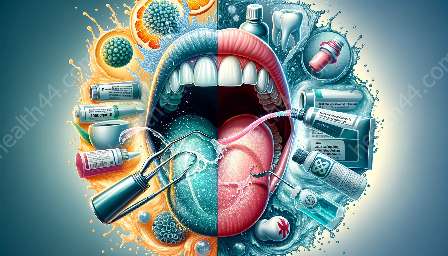When it comes to oral hygiene, mouthwash and oral rinses play a significant role in preventing gum disease. Understanding the similarities and differences between these two products can help in making informed choices for maintaining healthy gums and overall oral health. In this article, we will explore the connections between mouthwash and gum disease as well as mouthwash and oral rinses, shedding light on their benefits and usage.
Mouthwash and Gum Disease
Mouthwash, also known as mouth rinse, is a liquid product that is used to rinse the mouth and gargle. It often contains antiseptic and antiplaque agents that can help reduce the bacteria in the mouth. Gum disease, or periodontal disease, is a common condition characterized by inflammation of the gums and can lead to serious oral health issues if left untreated. Now, let's examine the similarities and differences between mouthwash and gum disease prevention:
- Similarities: Mouthwash can be a valuable tool in preventing and managing gum disease. When used as part of a comprehensive oral hygiene routine, it can help reduce the bacteria that contribute to gum inflammation and disease. Additionally, mouthwash can offer relief from the symptoms of gum disease, such as bad breath and gum sensitivity, providing temporary comfort while addressing the underlying issue.
- Differences: While mouthwash can contribute to gum disease prevention, it is important to note that it is not a standalone treatment for advanced gum disease. Professional dental care, including deep cleanings and other interventions, may be necessary to treat severe cases of gum disease. Additionally, different types of mouthwash may have varying levels of effectiveness in preventing gum disease, so it is essential to select a product that is specifically formulated for this purpose.
Mouthwash and Oral Rinses
Oral rinses, also known as mouth rinses or mouthwashes, refer to products designed to be swished around the mouth and then spat out. These rinses can serve various purposes, from freshening breath to reducing plaque buildup and preventing gum disease. Let's delve into the connections between mouthwash and oral rinses:
- Similarities: Both mouthwash and oral rinses aim to maintain oral hygiene by reducing oral bacteria and preventing gum disease. They can be used as part of a daily oral care routine to complement brushing and flossing, providing an additional layer of protection against gum disease and promoting overall oral health. Additionally, the antibacterial properties found in some oral rinses can target the specific bacteria associated with gum disease, aiding in prevention and control.
- Differences: While mouthwash and oral rinses share the common goal of preventing gum disease, their formulations may differ in terms of active ingredients and concentrations. Oral rinses may be specifically tailored to target certain aspects of oral health, such as reducing plaque or freshening breath, while mouthwash formulated for gum disease prevention may contain additional therapeutic agents. Understanding the specific benefits of each product can help individuals choose the most suitable option based on their oral health needs.
Conclusion
Understanding the similarities and differences between mouthwash and oral rinses in preventing gum disease can empower individuals to make informed decisions about their oral care. By incorporating these products into a comprehensive oral hygiene routine, individuals can take proactive steps to reduce the risk of gum disease and maintain optimal oral health. It is important to note that while mouthwash and oral rinses can be beneficial, they are not substitutes for regular professional dental care, and individuals should consult their dentists for personalized recommendations based on their oral health status.









